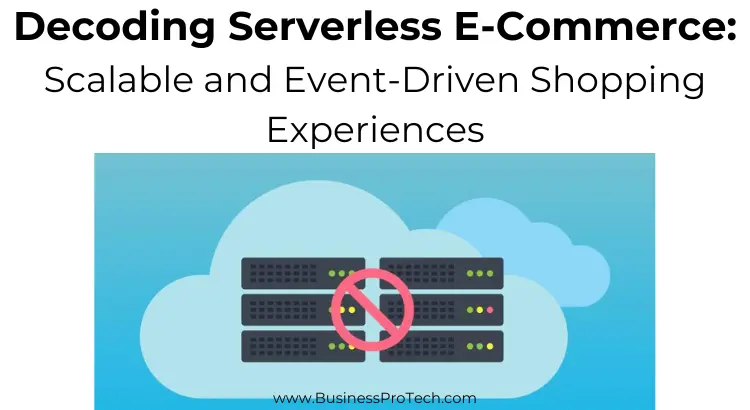Have you ever noticed how some online stores suggest precisely what you need? Say hello to serverless e-commerce. Serverless architecture is transforming online retail. It creates agile and cost-effective shopping platforms that meet consumers’ changing needs.
In this comprehensive guide, we’ll get down to the nitty-gritty of serverless e-commerce, discovering how this groundbreaking tech causes shopping experiences to seamlessly and, most importantly, instantly fall into place, perfectly tailored to each shopper’s whims and fancies.

The Building Blocks of Serverless Architecture
At its core, serverless e-commerce is built on a foundation that dynamically allocates resources. Imagine a puzzle where each piece represents a function, event, or resource. These pieces connect seamlessly, adapting in real time to users’ demands.
Functions are your application’s tasks or operations triggered by specific events like a product search or purchase. Resources, such as databases or storage services, are utilized only when needed, ensuring efficiency.
These elements work in harmony to create a fluid shopping experience capable of handling spikes in traffic or sales without a hitch. This architecture means that your e-commerce platform can scale up or down instantly, matching customer activity without manual intervention.
Why Go Serverless for Your E-Shop?
Although serverless may sound too good to be true, a growing number of businesses are adopting this innovative model not just for its immediate cost-savings and rapid ROI but also for the following benefits:
- Scalability Without the Sweat: Your store’s infrastructure scales based on real-time demand, ensuring seamless handling of any number of customers without lag or downtime.
- Cost-Effectiveness: Serverless computing lowers overhead expenses by letting you pay only for the resources you use, eliminating the need to buy unused gear or software.
- Enhanced Customer Experience: Engaging easily distracted shoppers requires faster load times and more seamless transactions. Thanks to serverless architectures, your e-commerce website will fulfill these requirements.
- Operational Efficiency: Serverless computing automates resource provisioning and scaling, freeing your team to develop new features.
- Flexibility and Innovation: Less infrastructure management gives your team greater leeway to test new products and services, spurring creativity and revealing untapped markets for income.
- Improved Reliability: Site outages are less likely with serverless architectures since they are highly available and fault-tolerant.
- Security: Using major cloud providers provides better security than a single e-commerce site could implement.
Real-World Applications of Serverless in E-Commerce
The rise of serverless technology is not just limited to theoretical discussions. It’s also finding significant adoption in real-world e-commerce scenarios. Here are a few ways in which it’s being used today:
- Personalized Shopping Experiences: By leveraging serverless functions, e-commerce platforms can scour users’ real-time behavior to offer products they might want to buy and suggest relevant discounts, providing a substantially better shopping experience and improving sales.
- Efficient Inventory Management: Serverless applications can be designed to update inventory levels, process returns, and manage restocks independently. This ensures that the storefront stays up-to-date with minimal manual intervention.
- Seamless Payment Processing: Payment gateways may be burdened with fluctuating demand during peak shopping. The serverless nature of computing resources supports this variable load, allowing for a smooth checkout process.
- Dynamic Pricing Models: Using serverless cloud, e-commerce businesses can adjust prices on the fly based on demand, inventory levels, and competitor pricing to generate maximum revenue.
- Automated Customer Support: Using chatbots and standard systems of serverless architectures ensures that common customer inquiries can be handled without human intervention, thereby reducing the time to respond and improving customer satisfaction.
As these examples demonstrate, serverless technology is helping e-commerce businesses operate more efficiently, react more rapidly to market changes, and deliver superior customer experiences.
As the technology matures, it will be interesting to see its increasing adoption and how it further transforms the e-commerce landscape.
The Role of Shopify and Expertise in Serverless E-Commerce

Moving an existing online business or starting a new one on a serverless e-commerce store like Shopify offers great uses for serverless technology. However, utilizing all the features serverless offers can take time and effort. This is where Shopify experts from a reputable agency can make a significant difference–between general development services and custom, tailored serverless e-commerce solutions.
Whether setting up the store or fine-tuning performance and premium feature integrations, with a Shopify expert in your corner, your e-commerce platform will work the way it was intended to and be ready for the growth this infrastructure can support.
Their knowledge of how to fully leverage what would have otherwise been a hidden gem in online retail’s highly competitive landscape is one of the easiest ways to keep on top.
Challenges and Considerations
Serverless e-commerce brings many benefits like flexibility, lower costs, and scalability, but there are challenges to consider:
- Technical Complexity: Moving from traditional to serverless architectures can be a steep learning curve for those used to server-based setups.
- Security Concerns: There’s a risk of vulnerabilities if access and permissions aren’t configured properly, despite the robust security measures of cloud providers.
- Third-Party Dependence: Your store’s performance and uptime can be affected by the reliability of external services.
- Cost Management: Traffic spikes can unexpectedly increase costs, even though serverless is generally cost-effective.
- Migration Challenges: Transitioning an existing platform to serverless can be complex, potentially leading to downtime and data loss.
A solid strategy can overcome these challenges, including thorough research, careful planning, and collaboration with serverless computing experts. Upskilling and preparing your staff for the change can avoid many of these issues, guaranteeing a seamless transition to serverless e-commerce.
Future Trends in Serverless E-Commerce

In the future, serverless e-commerce is bound to see further advancement. We can expect:
- Enhanced AI and Machine Learning Integration: With serverless computing expanding on artificial intelligence, customers can anticipate increasingly tailored shopping experiences with more precise predictions and recommendations.
- Greater Adoption of Microservices: Companies will divide more extensive, complex programs into smaller, easier-to-manage parts that are simpler to grow, update, and maintain.
- Improved Developer Tools and Ecosystems: The tools and services that will improve the efficiency and accessibility of development, deployment, and management will expand along with serverless computing.
- Sustainability: Serverless architectures contribute to a greener world since they are environmentally benign and resource-efficient.
These trends bode well for serverless e-commerce, indicating that efficiency, savings, and consumer satisfaction will continue upward. As technology evolves, it will undoubtedly open new doors for digital-age retailers to innovate and thrive.
Conclusion: The Serverless E-Commerce Revolution
Serverless e-commerce disrupts online retail, offering scalability and efficiency. Though challenging, it’s a viable option for innovating businesses. With expert help, dedication, and commitment, businesses can navigate serverless tech and shape the future of e-commerce for the benefit of all.